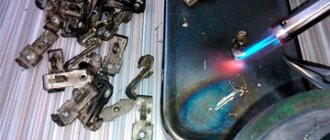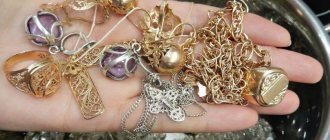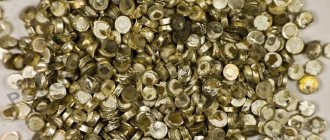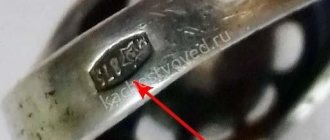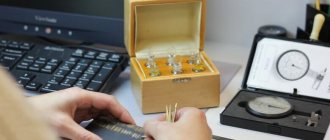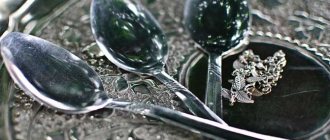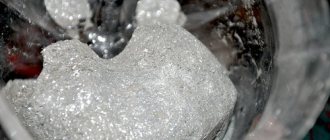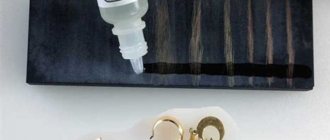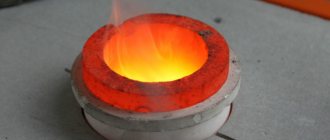Due to the chemical and physical properties of silver, the range of its use is very wide. The alloy can be used to create jewelry; it is included in radio components, circuit boards, microcircuits and other electronic elements. From them, as well as from jewelry scrap, a sufficient amount of material is obtained by melting for further use. Melting silver is not a complicated process if you understand the technology of its implementation, follow the sequence of actions and precautions.
Metal characteristics and melting point
Silver is more than 6,000 years old, as evidenced by archaeological finds in Turkey, Egypt and Iran. The second name of the precious metal is lunar, because according to esotericists, it is this luminary that serves as his patron, and the color resembles the cold shine of the Moon. In the past, this noble metal was valued more than gold.
Silver is characterized by the following physical properties:
- density - 10.6 g/cm3;
- hardness - soft and ductile;
- fusibility - high;
- thermal conductivity is the highest;
- electrical conductivity is the highest;
- reflectivity - yes.
The melting point of silver is 750-760 degrees.
Having decided to smelt silver yourself, you need to know the temperature at which the metal passes from a solid state of aggregation to a liquid state. It depends on the amount of foreign impurities in the composition. If the silver alloy includes a small amount of alloys, then its melting point will not exceed 750-760 degrees. The raw materials used in smelting are called charge. It is heated according to certain rules, taking into account the technological process, as well as observing safety precautions.
Principles of the procedure
What can be used for smelting? Absolutely all silver that is not used for its intended purpose is suitable for this procedure: fragments of jewelry, those that were left without a pair, microcircuits and circuit boards from radio components, production waste, ore, etc. Metal extraction occurs using the following technology.
- The raw materials are crushed to make it easier to work with.
- It is fired to remove flammable particles from the composition.
- Passed through a centrifuge to separate the molten precious metal from other components. The only exception is lead.
- Melting. As it cools, the liquid lead separates from the noble metal, which solidifies faster.
- It undergoes electrolytic treatment, which allows you to filter the precious metal dissolved in nitric acid from impurities.
Finally, chemical processing is carried out, thanks to which pure silver of the highest quality is obtained. To do this, the white metal is dissolved in a mixture of sulfuric acid, hydrochloric acid and ferric chloride, precipitating it with zinc. The required material is released from the solution in the form of sand, which is then washed and melted.
General information
Metal has been known to man since ancient times. Silver scrap was considered a strong and durable device, which ancient people learned to make even before our era. In addition, the material was often found in its native form; there was no need to melt ores to extract pure raw materials. Despite information from history claiming that ancient people did not know how to properly handle metal, today archaeologists find many household items and weapons made before our era.
The cultural traditions of different peoples differed, but many revered precious raw materials as a symbol of the moon. The population of Babylon and Assyria considered it to be a sacred metal. In the middle of the 12th century, most alchemists used the material in their experiments, which was possible due to its unique chemical properties.
Today, raw materials are mined in large quantities in Canada, Sweden, the USA, Russia, Kazakhstan, Norway, the Czech Republic and Slovakia. Many deposits make it possible to sell finished products at an adequate price. There is no shortage of metal today.
Melting silver at home
Melting silver is quite possible even without special knowledge and skills. The only condition is the presence of a suitable burner or stove. The equipment must meet the required parameters and be heated to a temperature suitable for these purposes.
Equipment and materials
When deciding to smelt silver, you need to make sure you have the necessary tools and materials. To work you will need:
- silver scrap;
- burner;
- fireproof container (crucible);
- casting mold;
- borax;
- forceps;
- metal container with cold water.
Crucible - container for melting silver
When everything you need is at hand, you can begin the experiment.
Batch preparation
To remelt silver, you will need to prepare a charge. To do this, scrap is crushed using pliers or metal scissors and mixed with borax (can be purchased at a pharmacy). The optimal composition ratio is 10:1, i.e. For every 10 g of precious metal, take 1 g of a chemical compound. The latter protects silver from oxidation. When heated, the borax turns green, acquires the viscosity of thick honey and burns out all the oxides from the alloy. The mixture is melted in a fireproof crucible, which is held with special tongs with long jaws.
Nuances of the smelting process
During melting, safety precautions must be observed. Due to the release of brown toxic gas, you need to work in a well-ventilated area with an open window or an exhaust hood turned on. It is advisable to protect yourself with a respirator and safety glasses.
In addition, silver in a heated liquid state has the property of absorbing oxygen. Each unit volume of metal absorbs 20 units of O2 volume. During the solidification of the alloy, the gas dissolved in it begins to release outward, breaking the hard crust formed on the surface. This leads to the appearance of splashes that fly in different directions in the form of streams and drops. The picture is, of course, beautiful, but very dangerous, because... Liquid metal coming into contact with an exposed body or surface can cause serious burns.
All flammable substances and flammable items are removed from the workplace. They wear an apron on top of their clothes or work in a special suit made of natural fabrics; their hands are protected with thick gloves.
The charge is placed in a heated crucible and exposed to it with a gas burner or placed in a furnace. The material is kept at high temperature until it completely melts. You can understand that this happened by the appearance of the surface of the silver liquid. It will be as shiny as mercury. If the surface does not shine, it means that the metal has not yet completely melted.
Step-by-step instruction
The melting point of 925 silver is +960−970 degrees, depending on the thickness of the product. Items with a lower standard or alloys with silver can melt already at +710 degrees. Experts say that the percentage of pure metal affects melting.
At a temperature of +2210 degrees, silver boils, so creating such conditions yourself is not recommended. Some people use a gas stove to manipulate silver. It is recommended to take into account that it is necessary to choose dishes that can withstand temperatures of at least +1000 degrees.
In specialized stores you can purchase special dishes designed for melting. All materials must be prepared in advance and placed in an accessible place. To prevent spontaneous combustion of furniture, an asbestos sheet is used, located on a table or other surface. Even if a spark or a drop of material enters, the risk of fire is minimized.
Alloy purification
If the manipulation will be carried out not with pure material, but with an alloy, it must first be cleaned of impurities. This is a separate procedure that is strictly prohibited to be performed independently, indoors. During cleaning, metals release toxins that are dangerous to the human body; if inhaled, poisoning develops quickly.
Cleaning occurs in several stages. The first is to place the silver, divided into several pieces, into a jar of nitric acid. The time it takes to free the metal from impurities varies. You should focus on the color of the acid. If it turns reddish, the cleaning was successful.
After this, a sodium chloride solution is added to the jar. Good silver will sink to the bottom. Next, clean water is added to the jar and drained after a few minutes. It is necessary to repeat the manipulations until the water becomes clear after topping up and light powder or granules settle to the bottom. They can be melted.
Melting technology
At home, melting silver is usually carried out in order to obtain some kind of jewelry, so it is necessary to prepare the mold in advance. If you choose the right one, after injecting the material, no additional actions will be needed. Sometimes the alloy should be rolled out to get smooth lines without sharp transitions.
The first step is to place a heatproof pan on the burner. Only after heating it is necessary to add purified powder or small pieces of silver if it does not need preliminary cleaning. When observing the heating, a person will notice how the crystals or pieces change shape and shade. The speed of the process depends on the size of the placed material.
Molten metal resembles a puddle of gasoline or mercury. The presence of a cloudy film on it indicates that the process is not over.
After the cloudy film disappears, you must quickly grab the container with tongs and carefully pour it into the prepared form. All movements must be clear, confident, fast, but very careful. Any jerk or delay will prevent you from realizing your plans.
If the prepared mold has a lid, place a piece of cotton wool of suitable size under it before closing it. During combustion, the material creates a certain pressure necessary for uniform distribution of the metal throughout the shape. In this case, you do not have to additionally roll out the mass.
Final stage
After crystallization of the material, it is necessary to separate it from the mold and place it in cold water. If all steps are performed correctly, the process is not difficult; the piece of silver separates on its own. If this does not happen, you should extract the silver yourself using tools.
Usually, the manipulations do not end at this stage, since it is necessary to make fastenings or other holes in the case when casting was carried out for the purpose of making jewelry. It is almost impossible to perform the procedure at home, especially in the absence of certain skills. To do this you will need tools and knowledge of jewelry making. Beginners stop there and give the master the opportunity to finish the job.
Melting silver at home is a complex, labor-intensive and often dangerous process that requires extreme concentration, composure, certain skills and suitable tools. Despite the apparent simplicity of implementation, it is strongly not recommended to do this in the absence of basic knowledge. Experts are also categorically against carrying out manipulations in a private house or apartment.
Features of melting silver in a microwave oven
If you don’t have a burner or oven, you can melt silver using a microwave. This is a quick and easy way to melt silver at home.
- Prepare a thermal protective fence into which a fireproof container is installed.
- The charge is poured into the crucible.
- The container is placed in a thermal protector and placed in the microwave oven at maximum power.
- The melting time is maintained, approximately 30-35 minutes.
- The molten metal is then removed and poured into the prepared mold.
Another way to melt silver is with a blowtorch. In this case, the crucible with the charge is located in a thick pipe made of fireclay clay of a larger diameter.
Silver smelting can be done with a blowtorch
Often, a special melting furnace is used to melt silver and other metals, which you can purchase or build yourself. It is installed in a separate room. The melting process is the same as when working with other equipment.
The result of melting silver at home depends on the expected complexity of the work. If you need pigs of any shape, then there will be no difficulties. When you want to get some kind of jewelry or decorative item, it is better to contact a craftsman.



